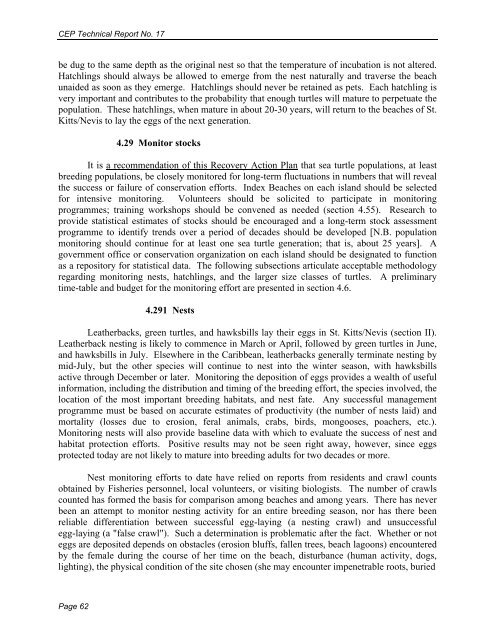Sea Turtle Recovery Action Plan for St. Kitts and Nevis - WIDECAST
Sea Turtle Recovery Action Plan for St. Kitts and Nevis - WIDECAST
Sea Turtle Recovery Action Plan for St. Kitts and Nevis - WIDECAST
Create successful ePaper yourself
Turn your PDF publications into a flip-book with our unique Google optimized e-Paper software.
CEP Technical Report No. 17<br />
be dug to the same depth as the original nest so that the temperature of incubation is not altered.<br />
Hatchlings should always be allowed to emerge from the nest naturally <strong>and</strong> traverse the beach<br />
unaided as soon as they emerge. Hatchlings should never be retained as pets. Each hatchling is<br />
very important <strong>and</strong> contributes to the probability that enough turtles will mature to perpetuate the<br />
population. These hatchlings, when mature in about 20-30 years, will return to the beaches of <strong>St</strong>.<br />
<strong>Kitts</strong>/<strong>Nevis</strong> to lay the eggs of the next generation.<br />
4.29 Monitor stocks<br />
It is a recommendation of this <strong>Recovery</strong> <strong>Action</strong> <strong>Plan</strong> that sea turtle populations, at least<br />
breeding populations, be closely monitored <strong>for</strong> long-term fluctuations in numbers that will reveal<br />
the success or failure of conservation ef<strong>for</strong>ts. Index Beaches on each isl<strong>and</strong> should be selected<br />
<strong>for</strong> intensive monitoring. Volunteers should be solicited to participate in monitoring<br />
programmes; training workshops should be convened as needed (section 4.55). Research to<br />
provide statistical estimates of stocks should be encouraged <strong>and</strong> a long-term stock assessment<br />
programme to identify trends over a period of decades should be developed [N.B. population<br />
monitoring should continue <strong>for</strong> at least one sea turtle generation; that is, about 25 years]. A<br />
government office or conservation organization on each isl<strong>and</strong> should be designated to function<br />
as a repository <strong>for</strong> statistical data. The following subsections articulate acceptable methodology<br />
regarding monitoring nests, hatchlings, <strong>and</strong> the larger size classes of turtles. A preliminary<br />
time-table <strong>and</strong> budget <strong>for</strong> the monitoring ef<strong>for</strong>t are presented in section 4.6.<br />
4.291 Nests<br />
Leatherbacks, green turtles, <strong>and</strong> hawksbills lay their eggs in <strong>St</strong>. <strong>Kitts</strong>/<strong>Nevis</strong> (section II).<br />
Leatherback nesting is likely to commence in March or April, followed by green turtles in June,<br />
<strong>and</strong> hawksbills in July. Elsewhere in the Caribbean, leatherbacks generally terminate nesting by<br />
mid-July, but the other species will continue to nest into the winter season, with hawksbills<br />
active through December or later. Monitoring the deposition of eggs provides a wealth of useful<br />
in<strong>for</strong>mation, including the distribution <strong>and</strong> timing of the breeding ef<strong>for</strong>t, the species involved, the<br />
location of the most important breeding habitats, <strong>and</strong> nest fate. Any successful management<br />
programme must be based on accurate estimates of productivity (the number of nests laid) <strong>and</strong><br />
mortality (losses due to erosion, feral animals, crabs, birds, mongooses, poachers, etc.).<br />
Monitoring nests will also provide baseline data with which to evaluate the success of nest <strong>and</strong><br />
habitat protection ef<strong>for</strong>ts. Positive results may not be seen right away, however, since eggs<br />
protected today are not likely to mature into breeding adults <strong>for</strong> two decades or more.<br />
Nest monitoring ef<strong>for</strong>ts to date have relied on reports from residents <strong>and</strong> crawl counts<br />
obtained by Fisheries personnel, local volunteers, or visiting biologists. The number of crawls<br />
counted has <strong>for</strong>med the basis <strong>for</strong> comparison among beaches <strong>and</strong> among years. There has never<br />
been an attempt to monitor nesting activity <strong>for</strong> an entire breeding season, nor has there been<br />
reliable differentiation between successful egg-laying (a nesting crawl) <strong>and</strong> unsuccessful<br />
egg-laying (a "false crawl"). Such a determination is problematic after the fact. Whether or not<br />
eggs are deposited depends on obstacles (erosion bluffs, fallen trees, beach lagoons) encountered<br />
by the female during the course of her time on the beach, disturbance (human activity, dogs,<br />
lighting), the physical condition of the site chosen (she may encounter impenetrable roots, buried<br />
Page 62
















